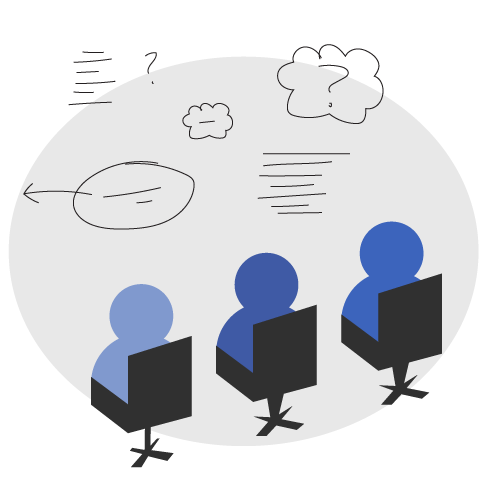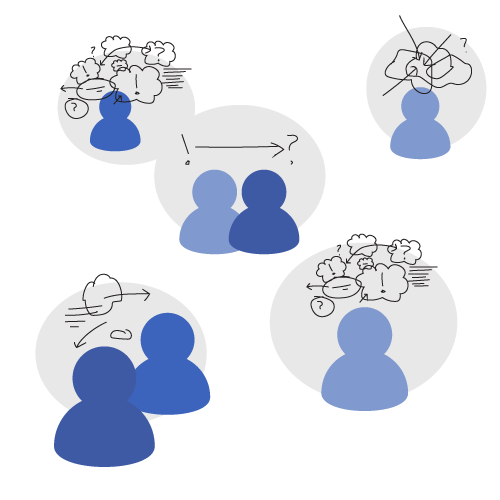Strategies for creative brainstorming are varied, and the concept is spoken and written about extensively.
There are teams that play creative games to spark collaboration. Here are 5 examples.
Some teams fill entire whiteboard walls with diagrams, words, and sticky notes. It ends up looking like this.
Other teams emphasize individual brainstorming sessions. Here's an article.
Ultimately, no one way is right for every company, but there’s a happy medium that any company can get behind to make brainstorming both productive and efficient.
It goes like this...
- Meet for an hour to introduce a creative problem and ask questions
- Break for a week so everyone can brainstorm individually
- Meet again and don’t leave the room until the problem is solved

The introduction meeting
To solve a problem or explore a creative idea, everyone needs to start on the same page.
Schedule a meeting for one hour to introduce the topic and challenges, and have everyone ask questions.
At this point, be wide open, but helpful questions would sound like...
“How extreme (or conservative) can we be?”
“Who are we really trying to reach with this idea?”
“Where will this creative end up?”
Brainstorming specific ideas is also helpful, but the focus of this first meeting shouldn’t be on the ideas. Some people aren’t comfortable being vulnerable so early in the process.
The other objective for the first meeting is to start a brainstorming document. We use Google Docs heavily at Brolik, but use whatever makes sense to organize the collaboration.
Ultimately, set up a structure for everyone to add ideas, questions, comments, research, or whatever else is needed into a single place. I like to start the doc with facts or guidelines at the top, and it’s helpful to include a table of contents, because these documents get long.
To recap, the goals of this initial meeting are…
- Introduce the topic and challenges
- Ask questions
- Create an organized brainstorm doc

Individual brainstorming
After the initial meeting, take a week (or at least a few days) for everyone to brainstorm on their own, in their own way.
This doesn’t mean everyone scurries back to their cubicle and throws on headphones. This could mean that smaller teams have side meetings, managers do one on one meetings, or people discuss ideas during lunch or happy hour.
To get the most out of people, especially creatively, we need to cater to their preferences and make them as comfortable as possible.
To get the most out of people creatively, cater to their preferences and make them comfortable.
Since everyone gets creative in different ways, it’s a mistake to force every personality type to publicly discuss their ideas in a conference room or lounge area.
For example, introverted minds are often some of the most creative minds on a team. Introverts like to wrap their heads around a problem and think through every last angle before putting pen to paper. The typical brainstorming process is not built for introverts.
Similarly, newer team members may have amazing insight due to their fresh perspective. Over time, teams that work together get set in their ways, and a new idea might be exactly what the team needs. It’s not always comfortable for a new employee to contribute a risky idea in a public setting, however.
Also, sometimes people get tired or have an off day. It’s not always convenient to brainstorm at the exact moment that everyone else is ready to.
Because of all that, setting aside time for individual brainstorming will get better results.
As long as things are organized (which is where the doc comes in), at the end of the week everyone will be ready to have the final meeting to talk about each others’ ideas and choose a winner. Those who enjoy traditional brainstorming methods will get their chance to shine at this point.
Before I dive into the final meeting, though, there’s one more benefit to this structure. It creates a deadline. It’s not always easy to force creativity, but a week is typically enough time to find and vet an idea, explore it and get it mostly finalized. By creating a hard stop, it ensures that the process doesn’t drag on.
The idea behind individual brainstorming is…
- Let team members brainstorm in their own way
- Let them brainstorm on their own time and schedule
- Everyone gets their thoughts into the doc before the final meeting

The final meeting
After everyone’s ideas are in the doc, the final follow up meeting is the last piece of the puzzle. This is where the final idea has to be chosen.
Forcing a final decision in this meeting ensures that the process doesn’t drag on, but it also creates appropriate pressure during the week while everyone brainstorms individually. They know that if the doc isn’t close, it requires more thought. On the other hand, if it’s clear the team can easily make a decision from what’s in the doc, then it’s ok to stop adding to it.
The meeting structure here isn’t as important as the end result of leaving with a solution.
Typically one person leads this meeting (maybe a project manager or lead), and he or she starts cleaning up the doc while everyone discusses.
I love to delete things at this phase. It feels good to get everything that won’t work out of the doc. Others like to use strikethrough so they can reference ideas that have been tossed out. Some like to bold or highlight the good stuff instead of removing the bad stuff.
Using whatever method you prefer, continually funnel that document down until an answer is reached, and make it a rule that new topics shouldn’t be opened up.
Sure, sometimes new ideas or directions arise, but try hard to keep that to a minimum. The point of brainstorming for the week prior is that all directions should have been explored or introduced.
The only thing to remember in the final meeting is...
- No one leaves until a solution is reached
That’s it... but please modify this process
What I’ve described works really well at Brolik. It may not be perfect for your team, but as a starting point, it will benefit any team.
Just remember the key takeaways for efficient and effective brainstorms…
- Be efficient with time and meetings
- Encourage all personality types to contribute by making them comfortable
- At some point, no one leaves the room until a solution is found
